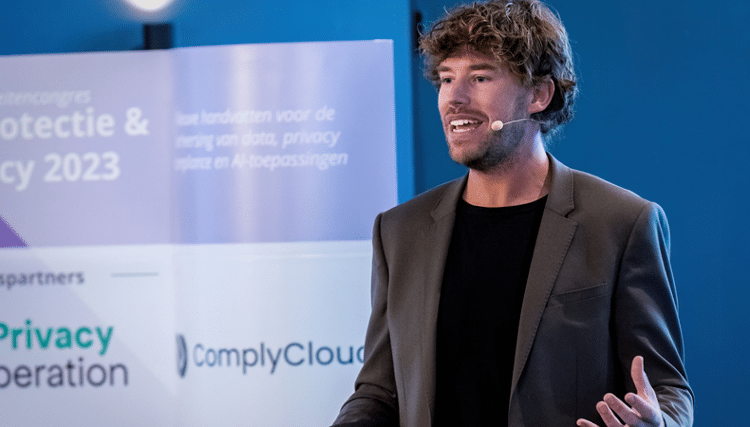Are AI agents the new internet?

We speak to AI and data expert Job van den Berg – keynote speaker at the recent FESPA Netherlands TREND conference – about how AI offers more than just image generation.
Printing may be one of the oldest industries, but its continued relevance and success is dependent on it being able to move with the times and adapt to emerging technologies and movements. FESPA Netherlands’ aptly named TREND conference (held in December 2024) was a perfect indicator that FESPA members are as receptive as ever to forward-thinking technology, specifically the growing influence of artificial intelligence.
“People are really eager for AI, and I don’t think people are feeling they will be replaced by it,” TREND keynote speaker and AI expert Job van den Berg says.
“Of course, the people who attended TREND might represent the more progressive part of the print sector, but they were very keen to learn more and work with AI. Some people are obviously scared about AI, but I hope my keynote made them think that there is huge potential in using generative AI, rather than it being a threat.”
In his own case, Job identified the potential of AI some time ago. Having done his master’s degree in statistics, Job worked for Kantar and then one of the largest publishers in the Netherlands, DPG Media. Throughout his career, Job was employed in a data director role, helping, he says, “to bridge the role of data scientist, AI and business’’.
He has since used the lessons he learned there to strike out on his own and, alongside his co-founder Remy Gieling, Job currently runs two businesses. The first is succinctly titled ai.nl and through that, Job and the team produce books, workshops and videos, and deliver speeches that look at the potential of AI.
“We do it a very practical way. Rather than going with high-sounding views about AI, we want to make it very tangible,” Job says.
The second of Job’s companies is called The Automation Group.
“This is more like an AI construction company. We have a team of developers who build customed-made AI solutions based on generative AI for companies,” Job says.
“We have a process that we call ‘AI in One Day’, where we build a proof of concept for a specific process – for example the process of writing sales proposals. We build the tooling in one day, and we do that because a lot of companies in the Netherlands talk about AI, but they never actually start experimenting with it. We say: just start with a proof of concept – a custom-made safe AI tool specific for your company – and then look at the IT challenges and how the technology can be incorporated into your organisation. We really believe you have to build, you have to start.”
Different strokes
Before you can begin any kind of implementation, though, Job says it’s important to understand that not all AI is equal, and AI technology itself comes in different forms.
“First of all, for a very long time we only had predictive AI – so-called ‘machine learning models’ – which uses data patterns to predict outcomes and help with decision making. But now we have generative AI, which can actually be used to create things,” Job says.
At Club FESPA Online, we have previously looked at the utility of generative AI for image creation, specifically with Midjourney. But generative AI’s potential power isn’t limited to simply producing novel visual compositions.
“Another pillar of generative AI is for hyper-personalisation,” Job says. “That is something we’ve been talking about for a very long time – sending the right marketing message to the right person at the right time. Often it hasn’t turned out that well because it is too expensive, or too labour-intensive to make thousands of versions of a specific advert. Now we can do it thanks to generative AI. AI can make personalised content, and automate hyper-personalisation, so we can now do it at scale.”
There are other, perhaps more functional, day-to-day situations where print companies can take advantage of generative AI too.
“The thing about generative AI is that it can also really help you with all kinds of cognitive types of tasks. Anything to do with communication, talking, information retrieval – there you can use generative AI,” Job says.
“It could help with writing proposals in a faster way or correcting false information that might be important for a specific task, or helping with chatbots. We know chatbots are useful but they eventually reach a point where they are unable to give a good answer to questions. By implementing generative AI, a chatbot can become much more intelligent and help people with more questions.
“So, there is huge potential to decrease overheads. You can use AI in the back office, in the front office, in the whole administrative area.”
Business case
Job says the way to benefit from such potential involves two options. The first – the “low-hanging fruit” as Job calls it – is to use ChatGPT or another chatbot as a kind of super-intern for tasks such as emailing.
“However, those types of AI chatbots are very good generalists but not so great as specialists,” Job says.
The second option is to combine your company’s own data with the technology and take advantage of the current leading edge of business-focused AI: AI agents.
“By using a large language model as the base technology, but infusing it with your company’s specific data, you can make it more specialist. Then you can use AI agents, which are actually large language models that can perform tasks autonomously,” Job says.
“That is already happening in Silicon Valley in the US; there are cognitive tasks that are being fully completed by AI agents in the workplace. For instance, they are being used to answer an email from a potential client and then write the subsequent proposal. So not only do they answer clients’ questions, they even create creative suggestions for a specific advert.”
Job is convinced the concept of AI agents is something that will gather momentum over 2025 – so much so that he is currently writing a book about it.
“For printers who want to prepare for this coming along, I would say: think about all your processes in your organisation and how you can work with AI in tandem with these processes,” Job says.
“What can AI help you with? Think about all tasks that involve retrieving and using huge amounts of information. That’s not something that humans are especially good at because we have a certain brain capacity, but large language models are really good at it.
“Think about how can you use AI for your organisation, knowing that it can help with all the cognitive functions in an organisation. Think about how you can use large language models and generative AI as a type of technology engine. Start with a use-by-use case: look at a specific process and think about how AI can help improve that process.
“And be ready for it. I firmly believe AI agents will have as radical an influence on our lives as the internet had.”
Become a FESPA member to continue reading
To read more and access exclusive content on the Club FESPA portal, please contact your Local Association. If you are not a current member, please enquire here. If there is no FESPA Association in your country, you can join FESPA Direct. Once you become a FESPA member, you can gain access to the Club FESPA Portal.
Recent news

Regulation guidance: Corporate Sustainability Reporting Directive
The Corporate Sustainability Reporting Directive (CSRD) is now in effect, but with further changes on the horizon, what does it mean for printers? Sustainability consultant Rachel England outlines everything you need to know and talks to Apigraf about how your business may be affected.

Web-to-print design: Canva versus Kittl
We look at popular design packages Canva and Kittl to determine how they compare regarding graphic design and print on demand.

FESPA in South Africa: the print skills to thrive
Printing SA’s Career Day inspired young Cape Town learners to explore printing and packaging careers.

The rise of Chinese printers
Chinese printing companies are on the rise, and have their eyes set on the UK and EU marketplace. Some have made an instant impact; others are running into issues with maintenance and language barriers. What does the future hold for Chinese printing firms, and how can you navigate working with them?